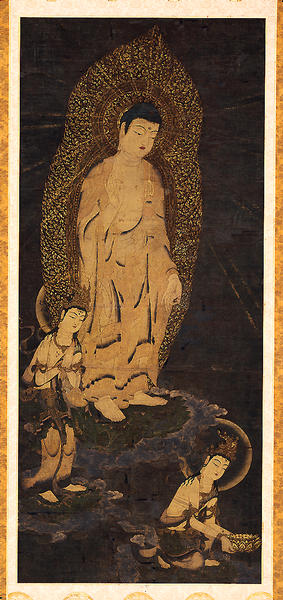Descent of Amitabha Triad
- Nambokucho period
- 14c
- Hanging scroll, color on silk
- H-112.7 W-49
- Formerly in the collection of the Akaboshi family
Catalogue Entry
Nambokucho period, 14th century
Hanging scroll, color on silk
Height, 112.7cm; width, 49.0cm
Kannon Bosatsu (Avalokites⇔vara) kneels with both knees down and holds out a lotus pedestal to save the soul being reborn. Seishi Bosatsu (Mahasthamaprapta), with knees slightly bent, leans forward with hands clasped in prayer, inclining toward the soul being reborn. Behind these 2 figures, a standing figure of Amida Nyorai with hands in the raigo mudra rides on a cloud. These three figures thus form a raigo image.
The bodies of the three deities are shown in gold paint layered on top of a tan red pigment ground, and the details of their figures are then picked out in cinnabar lines. Amida is wearing a jokesa (Kasaya), and the jo has a tan red pigment ground with hasukarakusa vining motifs drawn in gold paint. The denso sections have a yellow ground, gold paint motifs of thunder chains, and silver paint shading. This considerable use of gold and silver paint is characteristic of Buddhist paintings in the Kamakura and later periods. The glorious openwork nimbus which resembles a sculpted form is also depicted in gold paint.
On the other hand, the draperies of the two Bosatsus (Bodhisattva) are depicted in tan red pigment with the additional use of such polychrome pigments as white azurite, and gold paint is also used with these colors. The motifs used include vajra, seigaiha, and hemp leaf motifs, and all were popular in the Kamakura and later periods. The nimbuses of the Bosatsu are shaded in gold paint, and there is silver paint applied in washes to the raigo clouds. The background has been coated with ultramarine, a method frequently seen in raigo images.
This work has been traditionally ascribed to Takuma Choga, and yet the Honcho Gashi notes that, depending on the source, Takuma's name has been written with divergent characters and thus questions remain about the actual existence of this artist. There is no inscription or signature on this work as evidence towards this traditional attribution, and it seems to simply be a traditional attribution. The work was not created as far back as the early Kamakura period, the period of Choga's activities, and can be considered to date instead from the Nambokucho period. In spite of the fact that the work does not show the use of any cut gold leaf, it is noteworthy for its particularly effective use of both gold and silver paint, and for the gentleness of the expressions of the deities.
From the accompanying documents and the cinnabar seal on the box, it is known that the work was handed down in the Meiji period through the Matsudaira family of Kagawa prefecture and was later owned by the Akaboshi family. TI
